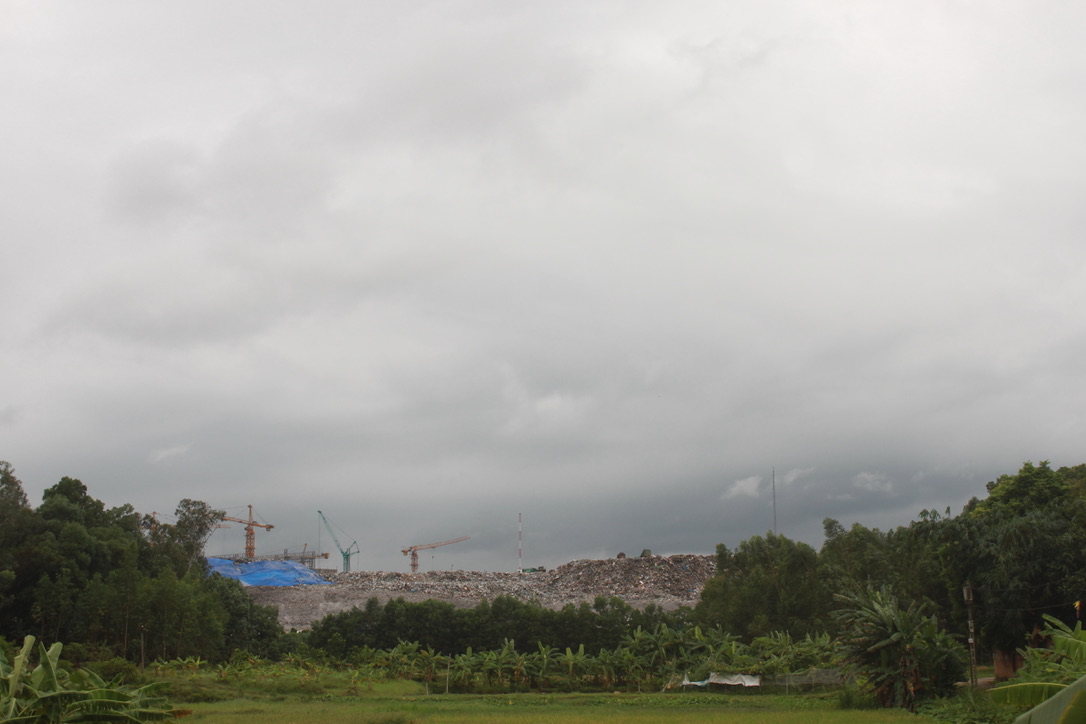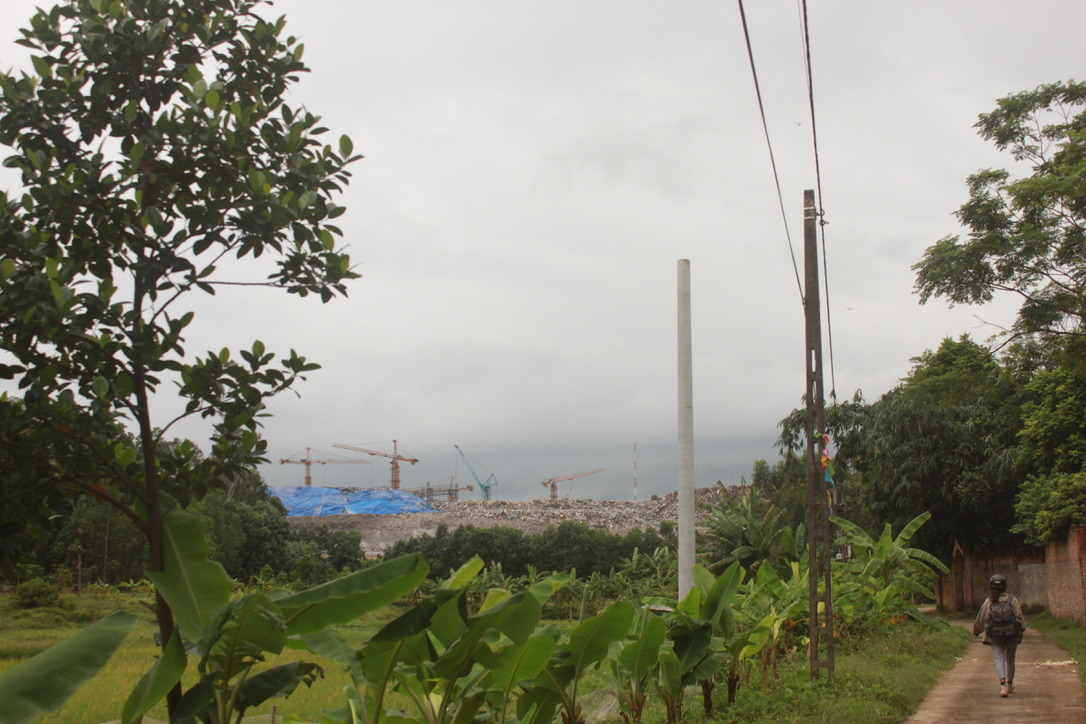You smell it before you see it. Black tarpaulin stretched over a mountain of solid waste, cranes and trucks moving endlessly over untreated trash, and smoke billowing from behind banana trees. This is Nam Son, Hanoi’s biggest landfill site, sitting alongside a village that 2,000 families still call home.
The Vietnamese capital produces around 6,500 tonnes of trash per day. Around 5,000 tonnes of that – a weight equivalent to around 4,000 cars – is collected and shipped off up to the Nam Son, just north of Hanoi. The rest goes to a smaller landfill site in Son Tay, or off to informal junkyards on the outskirts of the city, the so-called ‘craft villages’.
Phuong, a resident of Nam Son, is a farmer-turned-protester approaching the age of 70. She’s lived here her entire life, having had the land passed down through generations from her grandmother. She’s seen her hometown change first-hand, and explains that the mountain of waste now rivals that of the two actual mountains her village sits between.
Currently, about 85% of the country’s solid waste is being buried in landfill sites like Nam Son without being treated, with 80% of that unhygienic and polluting the environment. And while developers claim that it’s a well-run landsite by regional standards, locals rally against it, demanding better remuneration and lower pollution levels.
In terms of the site’s negative impact, on the lighter end of the scale is the smell, which lingers in the village, forcing locals to shutter their doors. But the site also contaminates drinking water in local wells and is suspected to have resulted in widespread cancer among local villagers.
“The government has already taken our farmland and turned it into landfill sites,” said Phuong, gently shaking her freshly picked kale in a stream that runs through her farm. Phuong’s stream is clean, unlike her neighbour’s, which is black and full of dead fish.
“Now, they want to take more, but they’re only willing to pay me 500k VND ($21) per square metre, because the land was owned by my parents. We need to build houses, and the cost of building a house is a lot more than they’ll pay for our land. After that, how will we eat? How will we pay for our food?”
This landfill, first built in 1999, today covers over 192ha – but it wasn’t always such a mammoth site. 10 trash burial slots were initially opened, making up 83ha, then a second including eight slots, making up 73ha. These were then filled, and another, southern area was created in 2015, which spanned 36ha. All of these were filled by 2019, forcing the Hanoi Urban Environment Company (Urenco) to add two more slots, and begin filling the gaps between the old ones.
Residents weren’t quite prepared for the site’s negative effects, either. In one study, officials confirmed that neither they, nor the residents, knew about how landfill could cause pollution, and were only led further from the truth as landfill proponents gave it ‘cleaner’ names, referring to it as a development project, and the Center for Solid Waste Processing.
Nam Son villagers have protested this site since it first opened, with demonstrations usually conducted using similar methods. The villagers send protest messages back to nearby Hanoi, both in the form of letters to the government and piles of trash, as residents block garbage trucks entering the landfill sites, leaving waste collectors no choice but to let refuse pile up in the capital.
Sometimes these messages work. In 2005 residents received about 40% of their requested compensation for pollution and land expropriation, as well as a new primary school for the community. But this is the exception, with the plight of Nam Son villagers usually falling on deaf ears. One villager referred to sending their protest letters some 15 years ago as “putting salt into the ocean” – a sentiment that still rings true today.
2016 saw an increase in protests, as the deluge of waste continued to pour into the area, with residents demanding an end to pollution and sufficient compensation for their land. Three communes were granted this in 2017 – Nam Son, Hong Ky, and Bac Son – but many of these families, like Phuong’s, are still yet to see this money.
But it’s not just the smell and money that the farmers are protesting. Phuong estimates that 80% of Nam Son villagers have cancer, mostly in their lungs, or in the form of thyroid tumors. One 2018 study, published in the Journal of Material Cycles and Waste Management, concluded that before the landfill opened up, there were no oncological diseases in the community. But, as the study showed, 40 people were reported to have died in the past three years from cancer, and around a dozen more were diagnosed with terminal cancer.
Phuong continued that cancer had claimed most of her family, and as the Globe spoke to her in late-September six people had just died from cancer in her village.
Measures have been taken to combat cancer within the community, with Phuong saying that the government covered 80% of the cost of prescription drugs for cancer treatment. But for many, the insurance simply wasn’t enough, with the price still insurmountable for elderly farmers, forced to beg for money.
“The price was too high for some of it, and we couldn’t afford it, so we couldn’t buy it,” she said.
As would be expected in household waste, much of what is thrown into Nam Son is hazardous, like batteries, chemicals, and heavy metals
Proposed resettlement areas have also become a point of contention for locals, who claim that the suggested area is still not far enough away from the landfill’s toxic fumes, and would rather stay in their villages where they grew up.
However, staying on this land, or any land within close proximity, would become inadvisable, as the landfill has slowly started seeping into the surrounding environment. It was, after all, only originally designed to handle around 2,000 tonnes of garbage a day. The amount has slowly increased to some 5,000 plus tonnes over time, and all of it buried, and improperly treated.
Fundamentally, the landfill was never designed to handle such a large amount of untreated waste.
The bottom had originally been covered with a layer of permeable fabrics laying on top of soil and rocks. But after 20 years, this has since decomposed, and as water now flows from the top of the landfill some 30 metres above into the bottom of the landfill, and subsequently into the surrounding environment.
As would be expected in household waste, much of what is thrown into Nam Son is hazardous, like batteries, chemicals, and heavy metals. It’s not properly treated, and is washed into the surface water and groundwater, and eventually causes serious environmental pollution.
Now, thanks to this improper treatment, both the air inhaled and the water drunk by local residents is highly contaminated with a high concentration of poisonous sediments in surface water, groundwater and vapours in the proximity of the landfill.


There are some, however, who see a more positive future for the landfill.
Back in June, the government issued a Public – Private Partnership (PPP) law which aims to attract more private and foreign investment into the development of Vietnam’s infrastructure, covering various sectors, including waste management.
One constructor, who works closely with the issue but declined to be named, is making the most of these new PPP laws. They claimed that this was “not a bad landfill” compared to most sites in the region. The constructor claimed to have observed various technologies and solutions being used at the landfill site, as well as segregating the landfill and sanitising it for future expansions. This is, they said, a positive step forward for Nam Son.
When trying to understand the difficulties in managing a landfill site such as this, the constructor compares it to constructing a building.
“If you made a mistake 20 years ago with the foundations of your building, it’s very hard to fix it because you have the whole building on top of it,” they said. “But what we know today is possibly smarter than what we knew 20-odd years ago when that was planned.”
Their company often works with the community when they take over landfill sites.
When the anger is too much, it’s like filling a dam with water. The dam is going to break
“We give them food, we give them training, we give them clothes. Along with that comes something very important. And that is pride. Because they get recognition for what they do. So they’re not considered the smelly guys with the bicycle on the side of the road, but they become a team, they get a sense of belonging.”
The constructor had one message that they would like to send to the residents of Nam Son. “You have to organise yourself,” they said. “And you’ve got to be ready to make a deal. And if you want to be happy with a deal, you’ve got to know what you want, once you walk away.”
According to the constructor, Nam Son’s residents should be more “opportunistic”.
“They could do better with the circumstance they are in,” they said. “Maybe not the 70 year old lady, I would not send her to scavenge stuff. I’m sure she has kids from other families that could. They don’t have another income, or work.”
This is a sentiment that, to some extent, Phuong agrees with. She sees that the young people within the village are still able to go and work – that they have the strength to work at the landfill site. But for the elderly farmers, the only way to survive is to beg. “We can’t live like this,” Phuong said.
Without what the farmers consider to be fair remuneration, without proper land to move into, and build houses, tensions are continuing to mount between the government and the Nam Son community. Perhaps the reported development being undertaken to lessen the issues at Nam Son will help to ease those tensions – but perhaps not.
“When the anger is too much, it’s like filling a dam with water,” said Phuong. “The dam is going to break.”


